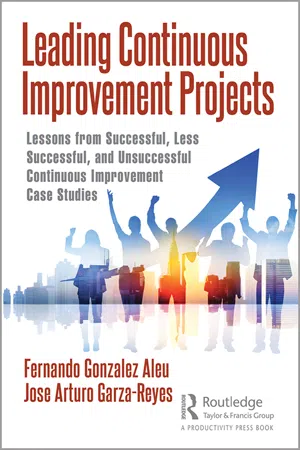
Leading Continuous Improvement Projects
Lessons from Successful, Less Successful, and Unsuccessful Continuous Improvement Case Studies
Fernando Gonzalez Aleu, Jose Arturo Garza-Reyes
- 148 Seiten
- English
- ePUB (handyfreundlich)
- Über iOS und Android verfügbar
Leading Continuous Improvement Projects
Lessons from Successful, Less Successful, and Unsuccessful Continuous Improvement Case Studies
Fernando Gonzalez Aleu, Jose Arturo Garza-Reyes
Über dieses Buch
This book is a reference for continuous improvement project (CIP) leaders/facilitators in manufacturing and service organizations, students (undergraduate and graduate), academics responsible for managing senior projects (Capstone Projects) and teaching quality courses, and researchers interested in how organizations could produce more effective and efficient continuous improvement initiatives and projects.
The authors collected and analyzed information and results from CIPs they facilitated or co-advised, such as the improvement of the service level in a bottle manufacturing organization, reduction of changeover in a brewery manufacturing organization, reduction of ambulance response time, and reduction of scrap in a steel transformation manufacturing organization. Many of the CIPs were previously part of award-winning white papers documenting critical improvements.
Throughout this book, readers will learn:
-
- different types of CIPs
-
- metrics to identify successful CIPs
-
- the 53 factors related to CIPs success
-
- how to manage CIPs
-
- behaviors to achieve outstanding results from CIPs.
Three of the chapters are supplemented with three or more case studies. In addition, the final chapter includes a list of behaviors expected from directors, continuous improvement managers, CIP leaders/facilitators, and CIP team members to obtain the major benefits from CIPs.
Häufig gestellte Fragen
Information
Part I
Continuous Improvement Projects and Success Factors
1

Continuous Improvement Projects (CIPs) Overview


1.1 Introduction

1.2 What Is a CIP?

1.3 Types of CIPs
- May use different improvement methodologies/tools and be known by different names. For example, a CIP may use Lean tools such as 5S or value stream mapping (and be called a Kaizen event, Lean project, rapid improvement event, or Lean event). It may use DMAIC (and be called a Six Sigma project). It may use a combined approach between Six Sigma and Lean (and be called a Lean Six Sigma project), or it may use a general improvement approach such as plan-do-check/study-act – PDCA or PDSA – (and be called a process improvement project or quality improvement project). In this book, these are all referred to as CIPs.
- May occur in a different timeframe. For instance, a CIP may take a day or few days from start to finish (such as with a Kaizen event or Lean event) or it may take several months (such as with a Lean Six Sigma project or Six Sigma project). CIP has a defined beginning vs. being a “standing” permanent team.
- May have one or more defined improvement goals focused on quality (such as errors or rework), costs, efficiency, timeliness, customer satisfaction, etc.
- May have minimal budget or investment to implement changes recommended or identified.
Types of CIP and definitions
| Type of CIP | Definition |
|---|---|
| General quality improvement project | Also known as process improvement project or just quality improvement project, is defined “as an organized effort on the part of three or more individuals with a designated team leader or facilitators to resolve a specific problem or undertaken activities to improve upon current practices that goes beyond the routine daily operation of the department or functional activity, or the normal responsibilities of a quality assurance committee” (Weiner, et al., 1997, p. 497) |
| Kaizen event | “A focused and structured improvement project, using a dedicated cross-functional team to improve a targeted area, with specific goals, in an accelerated timeframe” (Farris et al., 2008, p. 10) |
| Six Sigma project | The application of a rigorous problem solving methodology (define, measure, analyze, improve, and control – DMAIC) and advanced statistical tools (e.g. inference statistics, statistical process control and design of experiments) to reduce process variability (Breyfogle, 2003; Tang et al., 2007) |
| Lean Six Sigma project | Project focused on reducing process variability or eliminating waste through the integration of the rigorous Six Sigma project solving methodology (DMAIC) and advanced statistical tools, with Lean Production principals and tools.(Delgado et al., 2010; Furterer, 2016) |
